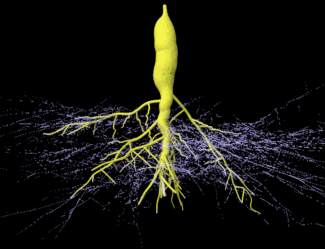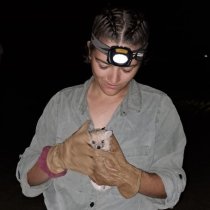Case Study
Digging Deeper into Carbon and Fungi in Eastern Forests
July 12, 2023
Forests hold a lot of carbon—not just in living trees and organisms, but in the soil beneath them. A recent paper in the Journal of Ecology explores correlations between tree species composition, fungal communities, and the relative abundance of different types of carbon in soil at seven NEON eastern forested field sites. Understanding these complex relationships could help researchers build better models of the carbon cycle in forested terrestrial ecosystems.
Dr. Ashley Lang, an NSF Postdoctoral Fellow in the Indiana University Department of Biology, explains, "Forests are a huge reservoir of carbon, and something like two-thirds of that carbon is actually underground. Historically, we've focused a lot of attention on what's happening above ground when we study the carbon cycle. But there has been a growing appreciation for soil as an important reservoir to study."
Lang's work was funded through a National Science Foundation (NSF) grant program. She presented her research at the 2022 ESA/CSEE joint meeting.
POM vs. MAOM: Why the Type of Organic Matter Matters
A lot of the carbon held in terrestrial ecosystems is sequestered in soil—by some estimates, nearly 80% of terrestrial carbon is stored in soil, or roughly 2500 gigatons globally. This includes both inorganic carbon (elemental carbon and carbonate minerals) and organic material, known as Soil Organic Matter (SOM). This is the fraction of soil that consists of carbon-containing compounds derived from plants, animals, microbes, and their byproducts. Particulate Organic Matter (POM) and Mineral-Associated Organic Matter (MAOM) are two important forms of SOM.
- POM is composed primarily of plant and animal matter in various stages of decomposition, along with the fungi and bacteria working to decompose them. POM is an important source of carbon and nutrients for living plants.
- MAOM is a form of organic matter that is chemically or physically bound to minerals in the soil. MAOM is typically smaller in size and more decomposed than POM. It is usually derived from the byproducts of microbial activity, dead microbial biomass, or organic compounds released from plant tissues through the action of water (like what happens when steeping tea).
Of these two forms, MAOM is generally considered more stable than POM. POM is material that is in an active state of decomposition; much of the carbon in POM ends up back in the atmosphere through the metabolic processes of microbial decomposers. This makes POM a relatively transient and short-lived pool of organic matter in soils.
MAOM, on the other hand, keeps carbon bound closely with minerals present in the soil, providing more stable long-term storage. Environments where more carbon is stored as MAOM are expected to be more stable as carbon sinks than environments that have a greater fraction of POM. Thus, understanding how the relative abundance of POM and MAOM varies across ecosystems is important for building more accurate models of the carbon cycle and terrestrial carbon sequestration.

In a 2023 paper, Dr. Ashley Lang explores correlations between tree species, fungi, and soil carbon soil at 7 NEON field sites. Photo credit: Ashley Lang.
Lang says, "For a long time, we've treated mineral-associated carbon in the soil as a relatively static pool; we know there is a bunch of carbon in there, and we assume most of it is going to stay there. But in reality, that's not the case—some forms of carbon in the soil can easily be lost from the system. The extent to which that is going to happen is something we really need to get some numbers on."
Trees, Fungi, and Soil Organic Carbon
The ratio of POM to MAOM can vary widely across different types of ecosystems and climate zones, but the drivers of those differences are not yet well understood. Lang and her coauthors hoped to discover how plant community composition, and the resulting fungal communities in the soil, are correlated with the relative abundance of MAOM vs. POM in different types of forests. She says, "If we want to manage land assets to maximize the carbon storage potential of soil, or even to simply be able to accurately predict how much carbon is in U.S. soil stores and how stable that carbon is, we need to understand that the drivers behave differently in different forest types. You can't just make one model of soil carbon and apply it to forests globally, because it is going to vary from place to place."

A visualization of a root tuber colonized by an arbuscular mycorrhizal fungus (2015). Credit: Wikicommons.
One hypothesis they wanted to test is whether the fungal communities in the soil are associated with different ratios of POM and MAOM, and how much variation there is in those relationships. Mycorrhizal fungi are fungal species that colonize the root systems of plants in a symbiotic relationship. In eastern U.S. forests, there are two main classes of mycorrhizal fungi, which are each associated with different tree species; arbuscular mycorrhizal fungi (AM) are found on trees including maple, ash, tulip poplar, and cedar, while ectomycorrhizal fungi (ECM) are found on species including oaks, beeches, birch, and most conifers. Previous studies have shown that forests with more AM fungi have higher proportions of mineral-associated carbon in the soil. Lang and her coauthors wanted to find out how well this pattern held up across different climate zones and forest types.
To do this, they analyzed soil samples from seven NEON terrestrial field sites representing different types of eastern forests, including Treehaven (TREE) in Wisconsin, Bartlett Experimental Forest (BART) in New Hampshire, Harvard Forest (HARV) in Massachusetts, Smithsonian Environmental Research Center (SERC) in Maryland, Oak Ridge National Lab (ORNL) in Tennessee, and Dead Lake (DELA) and Lenoir Landing (LENO) in Alabama. Having access to physical soil samples from each of the sites through the NEON Biorepository allowed Lang and her coauthors to compare soil characteristics from forests across climate zones in the eastern U.S.

An ectomycorrhizal fruiting body (Amanita spp) observed in a Tsuga canadensis stand at Harvard Forest (2012). Photo credit: Wikicommons.
"Being able to access samples from the bio archive allowed us to complete this work without having to travel to all of these places," Lang says. "The samples are all collected in the same way, which is really important for the analysis. And they are also associated with all kinds of other data, like soil chemistry and physical properties, plant community composition, even meteorological data. So, I can dig into all of these other datasets and see what else might be correlated, like soil texture."
The researchers performed chemical analysis to separate the POM and MAOM fractions of soil organic matter in each sample and to determine the amount of total amount of carbon and nitrogen held in each fraction. This gave them the ratio of POM to MAOM in each sample. Then, they looked at the tree species composition at the plot where each sample was taken and the type of fungi found in each of these locations.
As expected, they found that the relative abundance of POM vs. MAOM is linked to the type of fungi living in the soil (and, by extension, to the tree species composition above). However, the positive relationship between AM dominance and MAOM content is much stronger at northern forested sites compared to at southern sites. In fact, in the Alabama sites, they found more mineral-associated carbon under trees that support ECM fungi than under trees with AM fungi—the opposite of the pattern shown in northern forests.
While the study was not designed to test causation, Lang hypothesizes that the mechanisms driving the accumulation of MAOM may differ across climate zones. "It's a pretty complex question," Lang says. "We would need to know more about the volume and type of leaf litter, microbial biomass, and decay rates. NEON is actually pretty well set up to answer these types of questions in the future."
Now in the last year of her postdoctoral program, Lang is continuing her analysis of the NEON soil samples, this time to determine the stability of carbon in MAOM. She is treating mineral-associated soil from the NEON samples with oxalic acid, a common substance released from tree roots in the soil. She hopes to discover how much carbon is released from mineral surfaces through the action of oxalic acid and whether that also varies across locations. In August of this year, she will start a new postdoctoral position with the U.S. Forest Service, where she will continue her work on soil carbon chemistry.
Lang says, "Working with the NEON program has been great. The people there, especially Kelsey Yule at the Biorepository, have been very helpful—she even wrote a letter of support for my grant application. And NEON has so much data freely available. I would encourage anyone considering using the NEON data to reach out to the folks at NEON who are on the ground and working with the data every day."


